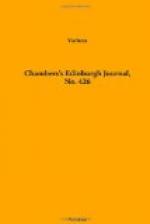’Much commendation is due to the teachers for their presence of mind. Miss M’Farland, one of the assistants in the primary department, finding the children of her department becoming alarmed, placed herself in the doorway, and exerted her utmost strength to arrest them as they endeavoured to rush from the room; and although several times thrown down and trampled upon, she still persisted in her efforts, until, finally, she was so much injured, as to be compelled to relinquish the post. So impetuous was the rush, however, that five of the teachers were forced over the balusters, and fell with the children into the well. The sterner discipline exercised over the boys’ departments prevented them generally from joining in the rush. Only three of the pupils in the upper male department were among the killed. Some of the boys jumped out of the windows, and one of them had his neck broken by the fall. As soon as they gained admittance, the police took possession of the premises, and commenced handing out the children from their perilous position. Those that were on the top were but slightly injured; but as soon as these had been removed, the most heart-rending spectacle presented itself. Some among the policemen were fathers, whose own children were there. They worked manfully, and body after body was taken out: many of them lifeless at first, came to when they once more breathed the fresh air; but many were beyond aid, and death was too plainly marked upon their pallid features. Some were injured by the fall, and lay writhing in agony; some moaned; while others shrieked with pain; and others, again, when released, started off for home, apparently unconscious of the awful scene through which they had passed. The bodies of the dead and wounded were mostly taken to the Ninth Ward Station-house, which is near the school. In a few minutes, news of the accident spread through the neighbourhood, and mothers came rushing to the scene by scores. Occasionally, a mother would recognise the lifeless form of a child as it was lifted from the mass, and then the piercing cry of agony that would rend the air! One after another, the bodies of the dead were removed; and at length litters were provided, and the wounded were carried away also. Nearly one hundred families either mourned the loss of children, or watched anxiously over the forms of the wounded.’
The coroner’s jury which sat on this case of wholesale destruction of life, decided that no blame could be imputed to any of the teachers in the school, and that the deaths were a result of accident. At the same time, they strongly condemned the construction of the stair, and the unfitness of the balustrades to withstand pressure. The whole case suggests the impolicy of giving spiral staircases to buildings of this class: in all such establishments, the stairs should be broad and square, with numerous landing-places.
Strangely enough, the sensation caused by the above catastrophe had not subsided, when another case of destruction of life occurred in New York from a similarly groundless fear of fire. This second disaster is noticed as follows in the newspapers:




